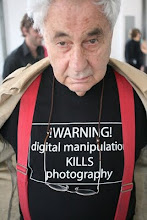 BAGHDAD CALLING Reports from Turkey, Syria, Jordan and Iraq
BAGHDAD CALLING Reports from Turkey, Syria, Jordan and IraqGeert van Kesteren texts: Jan Gruijters, Geert van Kesteren, Brigitte Lardinois, Edie Petersgraphic design: Mevis & Van Deursen
 BAGHDAD CALLING is an exceptional photography book. Photojournalist Geert van Kesteren shows how Iraqi refugees are living in Jordan, Syria and Turkey.
BAGHDAD CALLING is an exceptional photography book. Photojournalist Geert van Kesteren shows how Iraqi refugees are living in Jordan, Syria and Turkey.Besides these professionally shot images, the book reveals everyday life in the Iraq of 2006 and 2007 through the eyes of Iraqis themselves: a team round Van Kesteren amassed hundreds of photos from the mobile phones and digital cameras of Iraqi citizens that reveal places where journalists dare not tread for reasons of personal safety. These present a sequence of exploding grenades, family parties, ethnic cleansing, dancing in the park, demolished infrastructure, and hope of better times to come.
 The combination of professional photos, amateur snapshots and interviews with refugees, giving their first-hand accounts of the horrors that have befallen them, provides a penetrating insight into the situation in which the Iraqi citizens find themselves. Despite some optimistic reports in autumn 2007, the country is still in a state of collapse, into which it descended after the 2003 invasion.
The combination of professional photos, amateur snapshots and interviews with refugees, giving their first-hand accounts of the horrors that have befallen them, provides a penetrating insight into the situation in which the Iraqi citizens find themselves. Despite some optimistic reports in autumn 2007, the country is still in a state of collapse, into which it descended after the 2003 invasion. Baghdad Calling is an appeal to those countries of the Western coalition to shoulder their responsibilities and afford the Iraqis some hope of a better future.
Baghdad Calling is an appeal to those countries of the Western coalition to shoulder their responsibilities and afford the Iraqis some hope of a better future.See also Geert van Kesteren Why Mister, Why ? ... &
Vogue Iraq Partyland by Steven Meisel &
The Abu Ghraib Pictures by The New Yorker ...
 BAGHDAD CALLING is een bijzonder fotoboek. Fotojournalist Geert van Kesteren laat zien hoe Iraakse vluchtelingen leven in Jordanië, Syrië en Turkije. Naast die professioneel gemaakte beelden toont het boek het dagelijks leven in het Irak van 2006 en 2007 door de ogen van de Irakezen zelf: een team rond Van Kesteren verzamelde honderden foto’s uit mobiele telefoons en digitale camera’s van Iraakse burgers die plekken laten zien waar journalisten zich omwille van veiligheid niet begeven. Ontploffende granaten, familiefeesten, etnische zuivering, dansen in het park, een stukgeslagen infrastructuur en hoop op betere tijden wisselen elkaar af.
BAGHDAD CALLING is een bijzonder fotoboek. Fotojournalist Geert van Kesteren laat zien hoe Iraakse vluchtelingen leven in Jordanië, Syrië en Turkije. Naast die professioneel gemaakte beelden toont het boek het dagelijks leven in het Irak van 2006 en 2007 door de ogen van de Irakezen zelf: een team rond Van Kesteren verzamelde honderden foto’s uit mobiele telefoons en digitale camera’s van Iraakse burgers die plekken laten zien waar journalisten zich omwille van veiligheid niet begeven. Ontploffende granaten, familiefeesten, etnische zuivering, dansen in het park, een stukgeslagen infrastructuur en hoop op betere tijden wisselen elkaar af.De combinatie van professionele foto’s, amateurbeelden en interviews met vluchtelingen – getuigenissen van de verschrikkingen die hen zijn overkomen - geven een indringende kijk op de situatie waarin de Iraakse burgers zich bevinden. Ondanks enkele hoopvolle berichten uit het najaar van 2007 verkeert het land nog steeds in een staat van ontreddering, die is ontstaan na de inval in 2003 door een coalitie van westerse landen. Baghdad Calling is een oproep aan die landen om hun verantwoordelijkheid te nemen en de Irakezen een beter lot te verschaffen.
Lees meer : Foto's uit de no-go-area in Bagdad ... & Read more a review by 5B4 ...


















